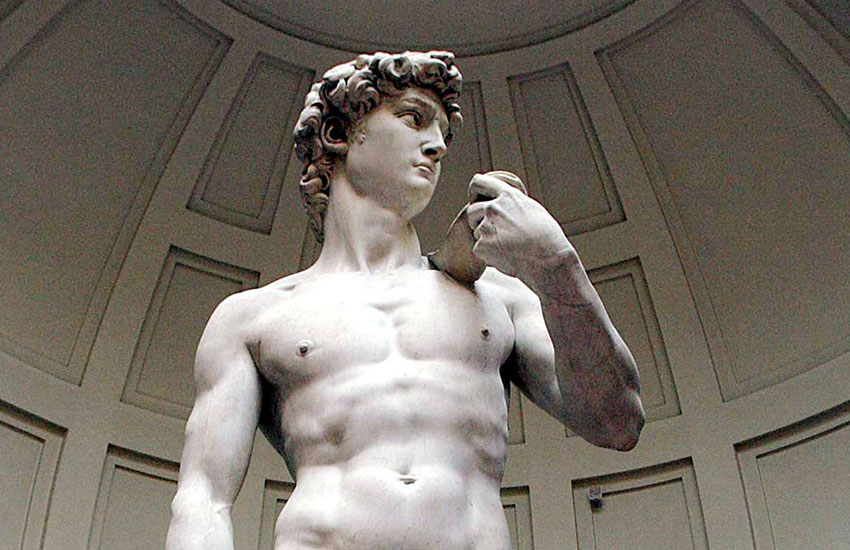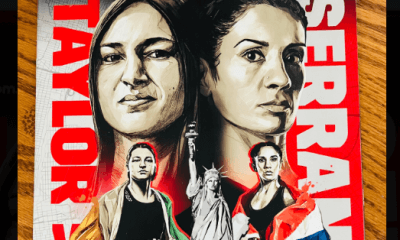Book Review
David vs. Goliath: Notes and Nuggets from Thomas Hauser
The Biblical battle of David vs. Goliath has endured for thousands of years as an inspiration for underdogs in one-on-one combat. But few people have written of that storied confrontation in a more intriguing fashion than Malcolm Gladwell.

The Biblical battle of David vs. Goliath has endured for thousands of years as an inspiration for underdogs in one-on-one combat. But few people have written of that storied confrontation in a more intriguing fashion than Malcolm Gladwell.
Gladwell authored a collection of essays published under the title David and Goliath (Little Brown and Company). The book examines nine individuals from various disciplines who battled powerful forces in contemporary times. The introduction to the book explores the original David vs. Goliath.
Three thousand years ago, the Bible tells us, an army of Philistines was seeking to militarily divide the Kingdom of Israel into two parts which would then be vulnerable to conquest. The warring armies faced each other from opposite sides of a ravine. Neither army dared attack since doing so would require descending into the ravine and being assaulted from above.
Finally, Gladwell writes, “The Philistines sent their greatest warrior down into the valley to resolve the deadlock one on one. He was a giant, six-foot nine at least [six cubits and a span] wearing a bronze helmet and full body armor. He carried a javelin, a spear, and a sword. An attendant preceded him, carrying a large shield. The giant faced the Israelites and shouted out, ‘Choose you a man and let him come down to me. If he prevail in battle against me and strike me down, we shall be slaves to you. But if I prevail and strike him down, you will be slaves to us and serve us.”
David, a shepherd boy who had come to the field of battle to bring food to his brothers, accepted the challenge. King Saul sought to dissuade him, warning, “Thou art not able to go against this Philistine to fight with him for thou art but a youth and he is a man of war.”
But David was insistent. You know the rest.
At least, you think you do.
“We consistently get these kinds of conflicts wrong,” Gladwell writes. “We misinterpret them. Giants are not what we think they are.”
Or phrased differently, in Gladwell’s eyes, David vs. Golaith wasn’t an evenly-matched fight. David had several crucial advantages.
“Goliath was expecting a warrior like himself to come forward for hand-to-hand combat,” Gladwell explains. “It never occurred to him that the battle would be fought on anything other than those terms. To protect himself against blows to the body, he wore an elaborate tunic made up of hundreds of overlapping bronze fishlike scales. He had bronze shin guards protecting his legs with attached bronze plates covering his feet. He wore a heavy metal helmet. He had three separate weapons, all optimized for close combat.”
All David had was a shepherd’s staff, a sling, and five smooth stones.
“Am I a dog that thou comest to me with sticks?” Goliath demanded of his young adversary. “Come to me and I will give thy flesh unto the fowls of the air and to the beasts of the field.”
Not so fast, big guy.
As recounted in 1 Samuel, chapter 17, verses 49 and 50, “David put his hand in his bag and took thence a stone and slang it and smote the Philistine in his forehead that the stone sunk into his forehead and he fell upon his face to the earth. Therefore, David ran and stood upon the Philistine and took his sword and drew it out of the sheath and cut off his head.”
Now for Gladwell’s keys to victory.
“Ancient armies,” he explains, “had three kinds of warriors. The first was cavalry: armed men on horseback or in chariots. The second was infantry: foot soldiers wearing armor and carrying swords and shields. The third were projectile warriors, or what today would be called artillery: archers and slingers. Slingers had a leather pouch attached on two sides by a long strand of rope. They would put a rock or a lead ball into the pouch, swing it around in increasingly wider and faster circles, and then release one end of the rope, hurling the rock forward. Slinging took an extraordinary amount of skill and practice. But in experienced hands, the sling was a devastating weapon. An experienced slinger could kill or seriously injure a target at a distance of up to two hundred yards. The Romans even had a special set of tongs made just to remove stones that had been embedded in some poor soldier’s body by a sling. And projectile warriors were deadly against infantry because a big lumbering soldier weighed down with armor was a sitting duck for a slinger who was launching projectiles from a hundred yards away.”
“Goliath is heavy infantry,” Gladwell continues. “He thinks that he is going to be engaged in a duel with another heavy-infantryman. When he says ‘Come to me,’ he means come right up to me so that we can fight at close quarters. David without armor has speed and maneuverability. He puts a rock into his sling and whips it around and around, faster and faster, aiming his projectile at Goliath’s forehead – the giant’s only point of vulnerability. What could Goliath do? He was carrying over a hundred pounds of armor. He was prepared for a battle at close range where he could stand, immobile, warding off blows with his armor and delivering a mighty thrust of his spear.”
“Goliath,” Gladwell quotes historian Robert Dohrenwend as saying, “had as much chance against David as any Bronze Age warrior with a sword would have had against an opponent armed with a .45 automatic pistol.”
Moreover, in many respects, Goliath seems to have been like an aging boxer past his prime.
“Goliath is supposed to be a mighty warrior,” Gladwell notes. “But he’s not acting like one. He comes down to the valley floor accompanied by an attendant – a servant walking before him, carrying a shield. Why does Goliath, a man calling for sword-on-sword single combat, need to be assisted by a third party carrying a shield? What’s more, why does he say to David, ‘Come to me’? Why can’t Goliath go to David? The biblical account emphasizes how slowly Goliath moves, which is an odd thing to say about someone who is alleged to be a battle hero of infinite strength. Why doesn’t Goliath respond much sooner to the sight of David coming down the hillside without any sword or shield or armor? When he first sees David, his first reaction is to be insulted. He seems oblivious of what’s happening around him. There is even that strange comment after he finally spots David with his shepherd’s staff: ‘Am I a dog that you should come to me with sticks?’ Sticks plural? David is holding only one stick.”
“What many medical experts now believe,” Gladwell continues, “is that Goliath had a serious medical condition. He looks and sounds like someone suffering from what is called acromegaly. One of the common side effects of acromegaly is vision problems. Why was Goliath led onto the valley floor by an attendant? Because the attendant was his visual guide. Why does he move so slowly? Because the world around him is a blur. Why does it take him so long to understand that David has changed the rules? Because he doesn’t see David until David is up close.”
“What the Israelites saw, from high on the ridge,” Gladwell concludes, “was an intimidating giant. There is an important lesson in that for battles with all kinds of giants. The powerful and the strong are not always what they seem.
****
If you think David went in tough . . .
One man fought both Jack Dempsey and Joe Louis. And the loser was . . . Jack Sharkey.
On July 21, 1927, in the next-to-last fight of Dempsey’s storied ring career, the Manassa Mauler knocked out Sharkey at Yankee Stadium in the seventh round. Five years later, Sharkey won a split decision over Max Schmeling to claim the heavyweight throne. But a year after that, he lost the crown by knockout to Primo Carnera.
Fast-forward to August 18, 1936, when Sharkey had the misfortune to enter the ring against Louis. It was the Brown Bomber’s first fight after suffering a devastating knockout defeat at the hands of Schmeling. The feeling was that Louis still might not be right.
The feeling was wrong. He KO’d Sharkey in the third round.
Thomas Hauser can be reached by email at thauser@rcn.com. His most recent book – There Will Always Be Boxing – was published by the University of Arkansas Press. In 2004, the Boxing Writers Association of America honored Hauser with the Nat Fleischer Award for career excellence in boxing journalism.
Check out more boxing news on video at The Boxing Channel
-

 Featured Articles4 weeks ago
Featured Articles4 weeks agoAvila Perspective, Chap. 330: Matchroom in New York plus the Latest on Canelo-Crawford
-

 Featured Articles3 weeks ago
Featured Articles3 weeks agoVito Mielnicki Jr Whitewashes Kamil Gardzielik Before the Home Folks in Newark
-

 Featured Articles1 day ago
Featured Articles1 day agoResults and Recaps from New York Where Taylor Edged Serrano Once Again
-

 Featured Articles6 days ago
Featured Articles6 days agoFrom a Sympathetic Figure to a Pariah: The Travails of Julio Cesar Chavez Jr
-

 Featured Articles4 weeks ago
Featured Articles4 weeks agoCatching Up with Clay Moyle Who Talks About His Massive Collection of Boxing Books
-

 Featured Articles1 week ago
Featured Articles1 week agoCatterall vs Eubank Ends Prematurely; Catterall Wins a Technical Decision
-

 Featured Articles3 weeks ago
Featured Articles3 weeks agoMore Medals for Hawaii’s Patricio Family at the USA Boxing Summer Festival
-

 Featured Articles4 weeks ago
Featured Articles4 weeks agoRichardson Hitchins Batters and Stops George Kambosos at Madison Square Garden





















